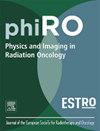通过弥散加权磁共振成像放射组学的整合改善口咽癌预后预测
IF 3.3
Q2 ONCOLOGY
引用次数: 0
摘要
背景与目的肿瘤区域复发(LRR)是头颈癌(HNC)放射治疗(RT)后失败的主要模式。预测个体患者LRR风险对于治疗前风险分层和治疗适应至关重要。本研究旨在评估将治疗前和治疗中期弥散加权(DW)-MRI放射学参数整合到HNC多变量预后模型中的可行性。材料与方法对178例接受化疗放疗(CRT)的口咽癌(OPC)患者进行DW-MRI扫描分析。从ADC图中提取了105个放射学特征。结合临床和放射学参数的Cox回归模型用于治疗前和治疗中期。经5次交叉验证,采用Harrel C-index评价模型的判别能力。结果灰度共生矩阵(GLCM)相关性作为治疗前局部区域控制(LRC)的显著放射学预测因子,c -指数(95% CI)为0.66(0.57-0.75)。重要的临床预测因素包括HPV状态、分期和酒精使用,c指数为0.70(0.62-0.78)。结合临床和放射学数据,c指数为0.72 (0.65-0.80),glcm相关性、疾病分期和酒精使用是重要的预测因素。中期治疗模型包括Δ (Δ)平均ADC、分期和额外化疗,c指数为0.74(0.65-0.82)。内部交叉验证的结果显示,临床、联合和中期治疗模型的c指数分别为0.60(0.51-0.69)、0.56(0.44-0.66)和0.63(0.54-0.73)。结论Δ ADC的加入改善了临床模型,突出了放射学特征在预后建模中的潜在补充价值。本文章由计算机程序翻译,如有差异,请以英文原文为准。
Improving outcome prediction in oropharyngeal carcinoma through the integration of diffusion-weighted magnetic resonance imaging radiomics
Background and purpose
Locoregional recurrence (LRR) is the primary pattern of failure in head and neck cancer (HNC) following radiation treatment (RT). Predicting an individual patient’s LRR risk is crucial for pre-treatment risk stratification and treatment adaptation during RT. This study aimed to evaluate the feasibility of integrating pre-treatment and mid-treatment diffusion-weighted (DW)-MRI radiomic parameters into multivariable prognostic models for HNC.
Materials and methods
A total of 178 oropharyngeal cancer (OPC) patients undergoing (chemo)radiotherapy (CRT) were analyzed on DW-MRI scans. 105 radiomic features were extracted from ADC maps. Cox regression models incorporating clinical and radiomic parameters were developed for pre-treatment and mid-treatment phases. The models’ discriminative ability was assessed with the Harrel C-index after 5-fold cross-validation.
Results
Gray Level Co-occurrence Matrix (GLCM)-correlation emerged as a significant pre-treatment radiomic predictor of locoregional control (LRC) with a C-index (95 % CI) of 0.66 (0.57–0.75). Significant clinical predictors included HPV status, stage, and alcohol use, yielding a C-index of 0.70 (0.62–0.78). Combining clinical and radiomic data resulted in a C-index of 0.72 (0.65–0.80), with GLCM-correlation, disease stage and alcohol use as significant predictors. The mid-treatment model, which included delta (Δ) mean ADC, stage, and additional chemotherapy, achieved a C-index of 0.74 (0.65–0.82). Internal cross-validation yielded C-indices of 0.60 (0.51–0.69), 0.56 (0.44–0.66), and 0.63 (0.54–0.73) for the clinical, combined, and mid-treatment models, respectively.
Conclusion
The addition of Δ ADC improves the clinical model, highlighting the potential complementary value of radiomic features in prognostic modeling.
求助全文
通过发布文献求助,成功后即可免费获取论文全文。
去求助
来源期刊

Physics and Imaging in Radiation Oncology
Physics and Astronomy-Radiation
CiteScore
5.30
自引率
18.90%
发文量
93
审稿时长
6 weeks
 求助内容:
求助内容: 应助结果提醒方式:
应助结果提醒方式:


